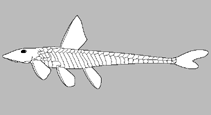Lamontichthys avacanoeiro de Carvalho Paixão & Toledo-Piza, 2009
Upload your photos and videos
Google imageNo image available for this species;
drawing shows typical species in Loricariidae.
Google imageNo image available for this species;
drawing shows typical species in Loricariidae.
Classification / Names Common names | Synonyms | Catalog of Fishes(genus, species) | ITIS | CoL | WoRMS | Cloffa
Teleostei (teleosts) > Siluriformes (Catfishes) > Loricariidae (Armored catfishes) > Loricariinae
Etymology: avacanoeiro: The species name, avacanoeiro, is in reference to the Avá-canoeiros, inhabitants from the upper rio Tocantins basin. Avá-canoeiros, an American group that historically inhabited the area of the upper rio Tocantins, drainage from which the examined.
Eponymy: Francesca Raimonde La Monte (1895–1982) was an ichthyologist who worked at the AMNH (1920–1968). [...] The Avá-canoeiros are an indigenous Brazilian people. Historically they lived in the upper Rio Tocantins basin, Goiás, where this catfish is found. (Ref. 128868), visit book page.
Etymology: avacanoeiro: The species name, avacanoeiro, is in reference to the Avá-canoeiros, inhabitants from the upper rio Tocantins basin. Avá-canoeiros, an American group that historically inhabited the area of the upper rio Tocantins, drainage from which the examined.
Eponymy: Francesca Raimonde La Monte (1895–1982) was an ichthyologist who worked at the AMNH (1920–1968). [...] The Avá-canoeiros are an indigenous Brazilian people. Historically they lived in the upper Rio Tocantins basin, Goiás, where this catfish is found. (Ref. 128868), visit book page.
Environment: milieu / climate zone / depth range / distribution range Ecology
Freshwater; demersal. Tropical; 48°S - 49°S, 13°W - 14°W
Distribution Countries | FAO areas | Ecosystems | Occurrences | Point map | Introductions | Faunafri
South America: Brazil. Upper rio Tocantins basin (Ref. 83332).
Size / Weight / Age
Short description Identification keys | Morphology | Morphometrics
Lamontichthys avacanoeiro differs from all congeners in the shorter first branched dorsal-fin ray (22.6-26.0%, vs. 26.4-40.5% SL) in specimens larger than 70 mm SL.
Lamontichthys avacanoeiro can be further distinguished from L. filamentosus, L. llanero, and L. maracaibero by the anterior tip of the snout with an oval shaped area without plates (vs. tip of snout totally covered with plates or, with only a very small area lacking plates), and by the teeth with long cusps (vs. short). Lamontichthys avacanoeiro can be further distinguished from L. filamentosus and L. llanero by the lower lip semi-oval shaped (vs. semicircular). Lamontichthys avacanoeiro also differs from L. maracaibero in having more than one plate between the base of the last pelvic-fin ray and the anterior margin of the anus (vs. one plate) and in the greater abdominal length in specimens larger than 150 mm SL (17.6-17.7% [n = 2], vs. 14.1-16.3% SL [n = 5]). Lamontichthys avacanoeiro can be distinguished from L. parakana by the more posterior location of the anal-fin origin (at the vertical through the distal tip of the last dorsal-fin ray, vs. anterior to that point), by the shorter unbranched anal-fin ray (16.9-20.3%, vs. 21.4-24.8% SL), and by the smaller orbital diameter (13.6-16.2%, vs. 16.6-17.3% HL) in specimens larger than 70 mm SL. Lamontichthys avacanoeiro also differs from specimens of L. parakana larger than 100 mm SL in the narrower head (91.3-100.9%, vs. 101.3-106.1% HL) (Ref. 83332).
Life cycle and mating behavior Maturity | Reproduction | Spawning | Eggs | Fecundity | Larvae
Main reference
Upload your references | References | Coordinator : Fisch-Muller, Sonia | Collaborators
de Carvalho Paixão, A. and M. Toledo-Piza, 2009. Systematics of Lamontichthys Miranda-Ribeiro (Siluriformes: Loricariidae), with the description of two new species. Neotrop. Ichthyol. 7(4):519-568. (Ref. 83332)
IUCN Red List Status (Ref. 130435: Version 2024-2)
Endangered (EN) (A3c); Date assessed: 07 November 2018
CITES
Not Evaluated
Threat to humans
Harmless
Human uses
FAO - Publication: search | FishSource |
More information
Trophic ecology
Food items
Diet composition
Food consumption
Food rations
Predators
Food items
Diet composition
Food consumption
Food rations
Predators
Ecology
Ecology
Ecology
Population dynamics
Growth parameters
Max. ages / sizes
Length-weight rel.
Length-length rel.
Length-frequencies
Mass conversion
Recruitment
Abundance
Growth parameters
Max. ages / sizes
Length-weight rel.
Length-length rel.
Length-frequencies
Mass conversion
Recruitment
Abundance
Life cycle
Reproduction
Maturity
Maturity/Gills rel.
Fecundity
Spawning
Spawning aggregations
Eggs
Egg development
Larvae
Larval dynamics
Reproduction
Maturity
Maturity/Gills rel.
Fecundity
Spawning
Spawning aggregations
Eggs
Egg development
Larvae
Larval dynamics
Anatomy
Gill area
Brain
Otolith
Gill area
Brain
Otolith
Physiology
Body composition
Nutrients
Oxygen consumption
Swimming type
Swimming speed
Visual pigments
Fish sound
Diseases & Parasites
Toxicity (LC50s)
Body composition
Nutrients
Oxygen consumption
Swimming type
Swimming speed
Visual pigments
Fish sound
Diseases & Parasites
Toxicity (LC50s)
Genetics
Genetics
Heterozygosity
Heritability
Genetics
Heterozygosity
Heritability
Human related
Aquaculture systems
Aquaculture profiles
Strains
Ciguatera cases
Stamps, coins, misc.
Aquaculture systems
Aquaculture profiles
Strains
Ciguatera cases
Stamps, coins, misc.
Tools
E-book | Field guide | Length-frequency wizard | Life-history tool | Point map | Classification Tree
| Catch-MSY |
Special reports
Download XML
Internet sources
AFORO (otoliths) | Aquatic Commons | BHL | Cloffa | BOLDSystems | Websites from users | Check FishWatcher | CISTI | Catalog of Fishes: genus, species | DiscoverLife | ECOTOX | FAO - Publication: search | Faunafri | Fishipedia | Fishtrace | GenBank: genome, nucleotide | GloBI | Google Books | Google Scholar | Google | IGFA World Record | MitoFish | Otolith Atlas of Taiwan Fishes | PubMed | Reef Life Survey | Socotra Atlas | Tree of Life | Wikipedia: Go, Search | World Records Freshwater Fishing | Zoobank | Zoological Record
Estimates based on models
Phylogenetic diversity index (Ref. 82804): PD50 = 0.5156 [Uniqueness, from 0.5 = low to 2.0 = high].
Bayesian length-weight: a=0.00389 (0.00181 - 0.00834), b=3.12 (2.94 - 3.30), in cm total length, based on LWR estimates for this (Sub)family-body shape (Ref. 93245).
Trophic level (Ref. 69278): 2.5 ±0.2 se; based on size and trophs of closest relatives
Resilience (Ref. 120179): Medium, minimum population doubling time 1.4 - 4.4 years (Preliminary K or Fecundity.).
Fishing Vulnerability (Ref. 59153): Low vulnerability (10 of 100).




